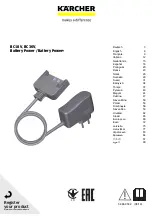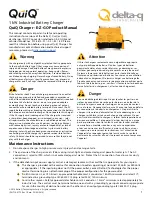
7
Part 1 (no load)
X
Make sure that there is no load on the alternator by turning
off all the vehicle's accessories.
X
The battery must be fully charged before testing the
alternator.
X
Run the engine long enough to achieve normal idle speed
and verify that there is a no-load voltage.
X
Press the alternator check pushbutton (9) to start the
check.
X
The alternator good LED (8) will light to indicate that the
alternator is good, or the fault LED (5) will display to indicate
that the alternator is out of typical voltage range.
X
Press the alternator check pushbutton (9) again to stop the
test.
Part 2 (under load)
X
Load the alternator by turning on as many accessories as
possible, except for air-conditioning and defrost.
X
Press the alternator check pushbutton (9) to start the test.
X
The alternator good LED (8) will light to indicate that the
alternator is good, or the fault LED (5) will light to indicate
that the alternator is out of typical voltage range.
X
Press the alternator check pushbutton (9) again to stop the
test.
If the first alternator check indicates a good alternator and
the second indicates the alternator is not good, the problem
could be caused by any of the following:
X
Loose fan belts.
X
An intermittent diode failure.
X
Bad connections between the battery and alternator and/or
ground.
Note:
The battery voltage pushbutton (10) is disabled in the
alternator check mode.
Note:
The fault LED (5) may display because a number of
extra accessory loads have been added to the charging
system, thereby increasing current demand from the
alternator. Make sure that the alternator is rated to support
the application.
Note:
This check may not be accurate for every make,
manufacturer and model of vehicle.
Approximate charging times
The battery charger will automatically adjust the charge rate
as the battery becomes charged and stop charging when the
battery is fully charged. Deep cycle batteries may require
longer charging times.
For estimates of the time it takes to charge a battery, refer to
the following table:
*NR = Not recommended at 2 A - use a higher charge rate.
The times shown in the table above are approximate and
refer to a 50 Ah automotive battery.
Example
A 50 Ah, 12 Vdc battery is discharged (50%). To determine
the time it takes to charge at the 10 A rate, see the chart
above under "50%" and "at 10 A rate".
The battery charging times will vary depending on the size,
age and condition of the battery. Smaller batteries should be
charged at a slower rate (SLO) and an extra hour added to
the charge time.
Maintenance
Your Black & Decker tool has been designed to operate over
a long period of time with a minimum of maintenance.
Continuous satisfactory operation depends upon proper tool
care and regular cleaning.
Warning!
Before performing any maintenance or cleaning on
the appliance, unplug the appliance.
X
From time to time wipe the appliance with a damp cloth. Do
not use any abrasive or solvent-based cleaner. Do not
immerse the appliance in water.
X
After each use, clean the battery clamps (4) and be sure to
remove any battery fluid that will cause corrosion of the
clamps (4).
X
Clean the outside case of the battery charger with a soft
cloth and, if necessary, mild soap solution.
X
Do not allow liquid to enter the battery charger. Do not
operate when the battery charger is wet.
X
Keep the battery charger cords loosely coiled during
storage to prevent damage to the cords.
Troubleshooting
Display indications, common problems and possible
solutions:
No Functions
X
Make sure that the battery charger is plugged into a live
230 Vac outlet.
X
Follow the steps outlined in the "Connecting the battery
charger" at the front of this manual.
% of charge in the battery
Rate
75%
50%
25%
0%
2A
7 hrs
14 hrs
NR*
NR*
6A
2.5 hrs
4.7 hrs
7 hrs
9.2 hrs
10A
1.4 hrs
2.8 hrs
4.2 hrs
5.5 hrs
Summary of Contents for BDV1084
Page 1: ...UK Ireland Australia New Zealand ...
Page 2: ...2 ...
Page 10: ...10 ...
Page 11: ...11 ...






























